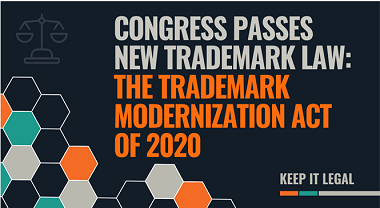The Trademark Modernization Act – Providing Answers to Irregularities
The Trademark Modernization Act of 2020 came into force in December 2020 in the US bringing some of the substantial change in the Lanham Act hoping to better protect the consumer from the confusion with regards to the source of the goods and service. This also brings some of the substantial change with regards to the expeditious address of the fraudulent trademark filing. Reducing the evidentiary burden of the trademark owner and resolving the circuit split. Some of the few changes and takeaways could be as follows-
Office Action Response Time
15 U.S.C 1062(b) provides with the refusal of registration, amendment of application, and abandonment. It says that if the applicant is found not entitled to registration, the examiner shall advise the applicant thereof and of the reasons therefor. The applicant shall have a period of six months in which to reply or amend his application. The new Act provides greater flexibility in setting the deadline. This act shortens the response deadline between 60 days to 6 months.
[Image Source: Global IP & Technology Law Blog]
Third-party submission of Evidence
This act gives the freedom to the third party to submit evidence while the examination of the Trademark application, bearing the registrability of the subject mark, is going on. Evidence with regards to the use of the mark is false or inaccurate can be submitted by the third party. Earlier there was no filing fee and therefore no specific deadline to file the same. This act brings up the deadline of 2 months to review the evidence submitted by the director of USPTO while establishing the appropriate procedures for the same.
Challenge to Registration
In the US, the applicant must use the mark in interstate commerce before qualifying for the registration. The practice of not using the mark has seen a significant rise in the number of registration issued. The act comes up intending to significantly reduce the number of registration which falsely claims the trademark use in the interstate. The USPTO has seen a higher rate of incidence with regards to false claims. This is damaging the new market participants who want to build the brand and thereby seek protection for their mark. Previously, the proving of the fraudulently secured mark was a lengthy process, initiating the trademark cancellation proceeding. This Act provides the procedures to review and cancel registrations in an expeditious manner.
Any third person can file a petition of expungement making the non-use of the mark as the ground. The petition can be filed and the director will commence the expungement proceeding targeting registrations issued under Section 44(e) or Section 66(a) of the Lanham Act.
Also, any person can file a petition to re-examine the mark again making the non-use of the mark as the ground, which will make the USPTO re-examine the mark. This option is available to any person before 5 years of registration. A much important move was that the party will not be required to prove their standing in either the expungement or re-examination proceeding. Instead, any person can initiate expungement or re-examination proceedings by submitting a petition to the Director of the USPTO that sets forth evidence or testimony establishing a prima facie case of non-use of a mark in commerce as of the “relevant date.” The Act requires that the petitioner supply evidence of a reasonable investigation as part of the petition to the Director. While the Act does not currently specify what constitutes a “reasonable investigation,” the Act charges the Director with creating regulations that (1) define what constitutes a reasonable investigation, and (2) identify the types of evidence that establish a prima facie case. (https://advertisinglaw.foxrothschild.com/2021/01/the-trademark-modernization-act-of-2020-is-enacted/)
Presumption of Irreparable Harm
According to the famous ruling of the Supreme Court in the case of eBay, Inc. v. MercExchange LLC, 547 U.S. 388 (2006), that there was no presumption of entitlement to an injunction in the patent context. This created some confusion about whether the presumption of entitlement to an injunction exists if the trademark owner proves trademark violation, therefore developing a circuit split. This act clarifies that a rebuttable presumption of irreparable harm exists if a trademark owner proves a trademark violation.
This act provides some of the very important provisions for the betterment of the trademark owner as well as for the third person initiating challenge against the trademark non-use. Providing with the procedures for the expungement and re-examination will prove to be very useful for those who claim any such false use of the trademark. Additionally, the Act provides courts and litigants with clarity regarding the showing of irreparable harm necessary to support a request for injunctive relief in litigation under the Lanham Act. This clarification should significantly reduce the incentive for forum shopping under prior law.
Author: Saransh Chaturvedi (an advocate) currently pursuing LLM from Rajiv Gandhi School of Intellectual Property Law (IIT Kharagpur). In case of any queries please contact/write back to us at support@ipandlegalfilings.com.




